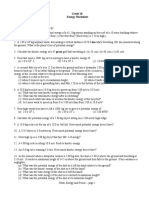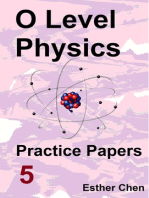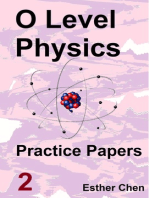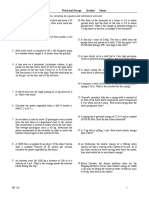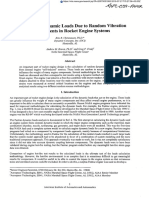Work and Energy Worksheet
Work and Energy Worksheet
Uploaded by
Syed Mairaj Ul HaqCopyright:
Available Formats
Work and Energy Worksheet
Work and Energy Worksheet
Uploaded by
Syed Mairaj Ul HaqOriginal Description:
Copyright
Available Formats
Share this document
Did you find this document useful?
Is this content inappropriate?
Copyright:
Available Formats
Work and Energy Worksheet
Work and Energy Worksheet
Uploaded by
Syed Mairaj Ul HaqCopyright:
Available Formats
Work and energy
1. When a body falls freely towards the earth, then its total energy
(a) Increases (b) decreases (c) remains constant (d) first increases and then decreases
2. A car is accelerated on a leveled road and attains a velocity 4 times of its initial velocity. In this
process the potential energy of the car
(a) Does not change (b) becomes twice to that of initial (c) becomes 4 times that of initial
(d) Becomes 16 times that of initial
3. In case of negative work the angle between the force and displacement is
(a) 00 (b) 450 (c) 900 (d ) 1800
4. An iron sphere of mass 10 kg has the same diameter as an aluminum sphere of mass is 3.5 kg.
Both spheres are dropped simultaneously from a tower. When they are 10 m above the ground, they
have the same
(a) Acceleration (b) momentum (c) potential energy (d) kinetic energy
5. A girl is carrying a school bag of 3 kg mass on her back and moves 200 m on a leveled road. The
work done against the gravitational force will be (g =10 m s2)
(a) 6 103 J (b) 6 J (c) 0.6 J (d) zero
6. Which one of the following is not the unit of energy?
(a) joule (b) Newton meter (c) kilowatt (d) kilowatt hour
7. The work done on an object does not depend upon the
(a) displacement (b) force applied (c) angle between force and displacement
(d) initial velocity of the object
8. Water stored in a dam possesses
(a) no energy (b) electrical energy (c) kinetic energy (d) potential energy
9. A body is falling from a height h. After it has fallen a height h/2 , it will possess
(a) only potential energy (b) only kinetic energy (c) half potential and half kinetic energy
(d) more kinetic and less potential energy
10. How are Joule (J) and ergs (erg) related?
(a) 1J = 10
7
erg (b) 1erg = 10
-7
J (c) 1J = 10
-7
erg (d) None
1. Work done = Force x _______
1. distance 2. Acceleration 3. Velocity 4. speed
2. 1 joule = 1 _______
1. N m2 2. 3. N m 4. N2 m2
3. Which form of energy does the flowing water possess?
1. gravitational energy 2. potential energy 3. electrical energy 4. kinetic
energy
4. A body of mass 2 kg is dropped from a height of 1m. Its kinetic energy as it touches the ground is
_______
1. 19.6 N 2. 19.6 J 3. 19.6 kg 4. 19.6 m
5. The unit of power is _______
1. watt per second 2. Joule 3. Kilojoule 4. joule per
second
6. 3730 watts = ______h.p.
1. 5 2. 2 3. 746 4. 6
7. A coolie carries a load of 500 N to a distance of 100 m. The work done by him is
1. 5 N 2. 50,000 Nm 3. 0 4. 1/5 N
8. The P.E. of a body at a certain height is 200 J. The kinetic energy possessed by it when it just
touches the surface of the earth is
1. > P.E. 2. < P.E. 3. = P.E. 4. cannot be known
9. Power is a measure of the _______
1. rate of change of momentum 2. force which produces motion
3. change of energy 4. rate of change of energy
10. Two objects of masses 1 x 10-3 kg and 4 x 10-3 kg have equal momentum. What is the ratio of
their kinetic energies?
1. 4:1 2. 2:1 3. 16:1 4.
11. A 40 newton object is released from a height of 10 m. Just before it hits the ground, its kinetic
energy, in joules is _______
1. 400 2. 3920 3. 2800 4. 4000
12. If the speed of an object is doubled then its kinetic energy is _______
1. doubled 2. Quadrupled 3. Halved 4. tripled
13. 1.5 kW = ______ watts
1. 1500 2. 150 3. 15000 4. 15
14. A man of mass 50 kg jumps to a height of 1 m. His potential energy at the highest point is (g =
10 m/s2)
1. 50 J 2. 60 J 3. 500 J 4. 600 J
15. The type of energy possessed by a simple pendulum, when it is at the mean position is
1. kinetic energy 2. potential energy 3. potential energy + kinetic energy
4. sound energy
16 An iron sphere of mass 30 kg has the same diameter as an aluminium sphere whose mass is 10.5
kg. The spheres are dropped simultaneously from a cliff. When they are 10 m from the ground, they
have the same _______.
1. acceleration 2. Momentum 3. potential energy 4. kinetic
energy
17. A 1 kg mass has a kinetic energy of 1 joule when its speed is
1. 0.45 m/s 2. 1 m/s 3. 1.4 m/s 4. 4.4 m/s
18. If air resistance is negligible, the sum total of potential and kinetic energies of a freely falling
body _______
1. increases 2. Decreases 3. becomes zero 4. remains the
same
19. Name the physical quantity which is equal to the product of force and velocity.
1. work 2. Energy 3. Power 4. acceleration
20. An object of mass 1 kg has potential energy of 1 joule relative to the ground when it is at a height
of _______.
1. 0.102 m 2. 1 m 3. 9.8 m 4. 32 m
Solution
1. (c) 2. (a) 3. (d) 4. (a) 5. (d) 6. (c) 7. (d) 8. (d) 9. (c) 10.(b)
1. 1 2. 3 3. 4 4. 2 5. 4 6. 1 7. 3 8. 1 9. 4 10. 1
11. 1 12. 2 13. 1 14. 3 15. 1 16. 1 17. 3 18 . 4 19. 3 20. 1
You might also like
- IB Physics Topic 2-4 Paper 1 ProblemsDocument20 pagesIB Physics Topic 2-4 Paper 1 Problemswonjunlim0819No ratings yet
- 08 Dynamics-Newton's 2nd LawDocument9 pages08 Dynamics-Newton's 2nd Laweltytan100% (1)
- Buoyancy WorksheetDocument2 pagesBuoyancy WorksheetMahmudul Hasan MonirNo ratings yet
- 4.1 Simple Harmonic Motion - WorksheetDocument12 pages4.1 Simple Harmonic Motion - Worksheetkoelia100% (1)
- Energy WorksheetDocument4 pagesEnergy WorksheetAlyssa Cole100% (1)
- Chapter 5 PDFDocument34 pagesChapter 5 PDFQassem MohaidatNo ratings yet
- Work Energy Power and Efficiency IB WorksheetDocument12 pagesWork Energy Power and Efficiency IB WorksheetAnonymous LZmFaXc100% (2)
- O level Physics Questions And Answer Practice Papers 3From EverandO level Physics Questions And Answer Practice Papers 3Rating: 3 out of 5 stars3/5 (1)
- O level Physics Questions And Answer Practice Papers 2From EverandO level Physics Questions And Answer Practice Papers 2Rating: 5 out of 5 stars5/5 (1)
- Selected Problems in Physics with AnswersFrom EverandSelected Problems in Physics with AnswersRating: 3 out of 5 stars3/5 (2)
- 2.1H ProjectilesDocument22 pages2.1H ProjectilesVictor KwanNo ratings yet
- Impulse and Momentum QuestionsDocument2 pagesImpulse and Momentum Questionsapi-301275445100% (1)
- Conservation of Energy QuizDocument2 pagesConservation of Energy QuizJay Noma Ramos100% (1)
- EfficiencyDocument2 pagesEfficiencyDanielGuimarãesCosta100% (1)
- IGCSE Physics - Newton's Laws of MotionDocument9 pagesIGCSE Physics - Newton's Laws of MotionKasunDilshanNo ratings yet
- Physics Liquid and Atmospheric Pressure WorksheetDocument2 pagesPhysics Liquid and Atmospheric Pressure WorksheetKuvuki TeveeNo ratings yet
- Impulse & Momentum Worksheets: Impulse: Momentum of The Bike: Momentum of The RiderDocument19 pagesImpulse & Momentum Worksheets: Impulse: Momentum of The Bike: Momentum of The RiderAsta WibawaNo ratings yet
- Higher Momentum and Impulse QuestionsDocument13 pagesHigher Momentum and Impulse QuestionsJames Craston0% (1)
- A2 MECH Momentum QuestionsDocument8 pagesA2 MECH Momentum Questionsfootball_frenzy_2004No ratings yet
- Maliyah Winston - Kinetic and Potential Energy WorksheetDocument3 pagesMaliyah Winston - Kinetic and Potential Energy Worksheetkaty collinsNo ratings yet
- 3.4 Power & EfficiencyDocument2 pages3.4 Power & EfficiencyCurtis Collins50% (2)
- Energy Efficiency WorksheetDocument2 pagesEnergy Efficiency WorksheetBen MasonNo ratings yet
- Energy Efficiency Worksheet and AnswersDocument2 pagesEnergy Efficiency Worksheet and AnswersЖеня Марченко100% (1)
- 7a - Work and Energy WorksheetDocument2 pages7a - Work and Energy Worksheetpicket1019No ratings yet
- 2016 IB Physics - Motion and ForcessDocument5 pages2016 IB Physics - Motion and ForcessGajendra100% (1)
- Electromagnetic EffectsDocument7 pagesElectromagnetic EffectsTran Phuong LinhNo ratings yet
- Length & Time IGCSEDocument5 pagesLength & Time IGCSEsapini100% (2)
- Mechanical Energy WorksheetDocument2 pagesMechanical Energy WorksheetEvelyn Atayde100% (2)
- Physics Worksheet Work and EnergyDocument2 pagesPhysics Worksheet Work and EnergyBahril Ilmiwan100% (1)
- As Level Physics Topic 3 Kinematics Lessons 1 2 WorksheetsDocument9 pagesAs Level Physics Topic 3 Kinematics Lessons 1 2 Worksheetsapi-183882946No ratings yet
- Energy Stores and Transfers WorksheetDocument3 pagesEnergy Stores and Transfers WorksheetAndreas LambriasNo ratings yet
- Newton 2nd Law PracticeDocument2 pagesNewton 2nd Law PracticeOdessa Niña PilapilNo ratings yet
- Physics Ib 10 Waves Worksheet AnswerkeyDocument2 pagesPhysics Ib 10 Waves Worksheet Answerkeyapi-301605346No ratings yet
- Simple Harmonic Motion Review Worksheet With AnswersDocument2 pagesSimple Harmonic Motion Review Worksheet With AnswersVicious core100% (1)
- P3 JAN 21 Revision Worksheet All ChaptersDocument3 pagesP3 JAN 21 Revision Worksheet All ChaptersSheikh HassanNo ratings yet
- Answers To Test Yourself Questions: Topic 8Document7 pagesAnswers To Test Yourself Questions: Topic 8Abel CruzNo ratings yet
- IGCSE Thermal Physics WorksheetDocument1 pageIGCSE Thermal Physics Worksheetgdsuta67% (3)
- Simple Harmonic Motion Pendulum and Spring-ProblemsDocument2 pagesSimple Harmonic Motion Pendulum and Spring-ProblemsVedantNo ratings yet
- Gravitational Force WorksheetDocument4 pagesGravitational Force WorksheetAnjela AprilNo ratings yet
- PHYS 151 Homework 6Document7 pagesPHYS 151 Homework 6QuinnNgo100% (1)
- Physics Worksheet PDFDocument10 pagesPhysics Worksheet PDFanas ahmed100% (1)
- Mass, Weigth and Density IGCSEDocument6 pagesMass, Weigth and Density IGCSEsapiniNo ratings yet
- Turning Effect of Forces - Worksheet 3Document5 pagesTurning Effect of Forces - Worksheet 3Azhar IqbalNo ratings yet
- Igcse 51 Density&PressureDocument40 pagesIgcse 51 Density&PressureHany ElGezawyNo ratings yet
- 02 Kinematics PDFDocument10 pages02 Kinematics PDFMuhammad Furqan MemonNo ratings yet
- COAS P1 04 Acts WsDocument2 pagesCOAS P1 04 Acts WsherawatiNo ratings yet
- Work Energy Worksheet 1Document5 pagesWork Energy Worksheet 1TheOnesNo ratings yet
- Worksheet - AccelerationDocument2 pagesWorksheet - AccelerationMADHAVI BARIYANo ratings yet
- Terminal VelocityDocument18 pagesTerminal VelocityZubairHassanNo ratings yet
- Potential and Kinetic Energy Worksheet: Name: . DateDocument4 pagesPotential and Kinetic Energy Worksheet: Name: . DateJamar FraserNo ratings yet
- Momentum WorksheetDocument4 pagesMomentum WorksheetemilyNo ratings yet
- IGCSE Forces&ShapeDocument28 pagesIGCSE Forces&ShapeAbhay Bhingradia100% (1)
- Kinematics WorksheetDocument9 pagesKinematics WorksheetLai Kee KongNo ratings yet
- Elements and Compounds For MYP 3Document18 pagesElements and Compounds For MYP 3Maira ButtNo ratings yet
- WORK Sheet PressureDocument6 pagesWORK Sheet PressureSherazNo ratings yet
- Math 1st Year2Document4 pagesMath 1st Year2Syed Mairaj Ul HaqNo ratings yet
- Ba Bcom Basc Weekly TestDocument1 pageBa Bcom Basc Weekly TestSyed Mairaj Ul HaqNo ratings yet
- Bcom II Management NotesDocument81 pagesBcom II Management NotesSyed Mairaj Ul HaqNo ratings yet
- Ba Bcom Basc Weekly TestDocument1 pageBa Bcom Basc Weekly TestSyed Mairaj Ul HaqNo ratings yet
- Xii CGDocument59 pagesXii CGSyed Mairaj Ul HaqNo ratings yet
- Ali Notes For CentreDocument5 pagesAli Notes For CentreSyed Mairaj Ul HaqNo ratings yet
- Wave Notes 4 - Refraction1Document5 pagesWave Notes 4 - Refraction1Syed Mairaj Ul HaqNo ratings yet
- Professor Jee Collegiate: Class IxDocument2 pagesProfessor Jee Collegiate: Class IxSyed Mairaj Ul HaqNo ratings yet
- Energy Notes 3 - Conservation of EnergyDocument5 pagesEnergy Notes 3 - Conservation of EnergySyed Mairaj Ul HaqNo ratings yet
- Xi-Xii Coaching ProgramDocument1 pageXi-Xii Coaching ProgramSyed Mairaj Ul HaqNo ratings yet
- Wave Notes 3 - Reflection1Document5 pagesWave Notes 3 - Reflection1Syed Mairaj Ul HaqNo ratings yet
- Stars Academy: PU Pharm.D Mcat Ecat NTS Fast Nust Giki LumsDocument2 pagesStars Academy: PU Pharm.D Mcat Ecat NTS Fast Nust Giki LumsSyed Mairaj Ul HaqNo ratings yet
- Personal Details: Applicatin Form For TutorDocument13 pagesPersonal Details: Applicatin Form For TutorSyed Mairaj Ul HaqNo ratings yet
- UHS MCAT Entry Test Syllabus 2015Document36 pagesUHS MCAT Entry Test Syllabus 2015Shawn Parker89% (9)
- Ministry of Inter Provincial Coordination (IPC Division) : S T NS T NDocument3 pagesMinistry of Inter Provincial Coordination (IPC Division) : S T NS T NSyed Mairaj Ul HaqNo ratings yet
- Calculation of Dynamic Loads Due To Random Vibration Environments in Rocket Engine SystemsDocument31 pagesCalculation of Dynamic Loads Due To Random Vibration Environments in Rocket Engine SystemsPrasanna DissanayakeNo ratings yet
- 4.4.2.1 Shallow Bearing Foundations: γ is the weightDocument13 pages4.4.2.1 Shallow Bearing Foundations: γ is the weightDone NikolovskiNo ratings yet
- Phys12 SM 05 RDocument35 pagesPhys12 SM 05 RZain IsmailNo ratings yet
- NIT W ThermalDocument78 pagesNIT W ThermalKharaPrasadNo ratings yet
- Group 4 Structures Lab Report 7Document6 pagesGroup 4 Structures Lab Report 7Roshan RameshNo ratings yet
- Structural Steel Design L 03A-19.11.2021Document74 pagesStructural Steel Design L 03A-19.11.2021LUGHANO NGAJILONo ratings yet
- 2/5 Normal and Tangential Coordinate (N-T) : 2103-212 Dynamics, NAV, 2012Document15 pages2/5 Normal and Tangential Coordinate (N-T) : 2103-212 Dynamics, NAV, 2012Bharadwaj SubramaniamNo ratings yet
- Thermo ProjectDocument37 pagesThermo Projectch23b012No ratings yet
- Rigid PavementsDocument84 pagesRigid PavementsVizag Roads89% (9)
- Grade 11 Projectile Motion Lab: InstructionsDocument4 pagesGrade 11 Projectile Motion Lab: InstructionsOmar AlbstkiNo ratings yet
- Arango (1996) Scaling Factors: Table 3Document1 pageArango (1996) Scaling Factors: Table 3RaghavNo ratings yet
- Structural ReportDocument85 pagesStructural ReportSravani PrabhalaNo ratings yet
- Gas Dynamics: Instructor: Dr. AsadullahDocument17 pagesGas Dynamics: Instructor: Dr. AsadullahM Rakeeb BalochNo ratings yet
- OptiStruct 2019 VerificationProblemsDocument155 pagesOptiStruct 2019 VerificationProblemsKalpesh JoshiNo ratings yet
- CRDDocument9 pagesCRDSamuel AbebawNo ratings yet
- Computation of The Effective Lamination Stack'S Behavior Considering The Contact Simulation With A Multi-Scale HomogenizationDocument10 pagesComputation of The Effective Lamination Stack'S Behavior Considering The Contact Simulation With A Multi-Scale HomogenizationSidharth MaheshNo ratings yet
- Soil Tire InteractionDocument25 pagesSoil Tire InteractionsiritapeNo ratings yet
- Lumped Capacitance ExperimentDocument10 pagesLumped Capacitance ExperimentDorian GreyNo ratings yet
- 1.5.5 - 6. Turning Effect of Forces (O Level 23-25)Document24 pages1.5.5 - 6. Turning Effect of Forces (O Level 23-25)EmmaNo ratings yet
- SkyCiv Beam Summary Report - VOXXGxJyAKneLvy1PoCJwgX53oG4J78vDocument7 pagesSkyCiv Beam Summary Report - VOXXGxJyAKneLvy1PoCJwgX53oG4J78vBastian David Castro BastiasNo ratings yet
- Physical Sciences Memo Mar-2024 Grade 11 Controlled TestDocument5 pagesPhysical Sciences Memo Mar-2024 Grade 11 Controlled Testmatodziraphalalani6No ratings yet
- RVFDocument31 pagesRVFephNo ratings yet
- Experiment # 01: To Determine The Buckling in Column Due To LoadingDocument6 pagesExperiment # 01: To Determine The Buckling in Column Due To LoadingNoman AliNo ratings yet
- 13e Chap 08Document144 pages13e Chap 08kaiNo ratings yet
- suggestedDemosToCorrespondingPhysicsTextbooks PDFDocument292 pagessuggestedDemosToCorrespondingPhysicsTextbooks PDFWilliam SaaNo ratings yet
- Chemistry 2Document4 pagesChemistry 2Wenralf NagangdangNo ratings yet
- MCAE 410 Chapter 2 - Heat Conduction Equation - Part 3 (Problems)Document4 pagesMCAE 410 Chapter 2 - Heat Conduction Equation - Part 3 (Problems)ethan mackanickNo ratings yet
- Particle-Size Reduction - Chemical Engineering - Page 1Document7 pagesParticle-Size Reduction - Chemical Engineering - Page 1Rahul ChandrawarNo ratings yet
- Free Fall PresentationDocument27 pagesFree Fall PresentationRowena Sta MariaNo ratings yet
- B.Tech Assgn-1Document6 pagesB.Tech Assgn-1K Pushpendu PrashantNo ratings yet




